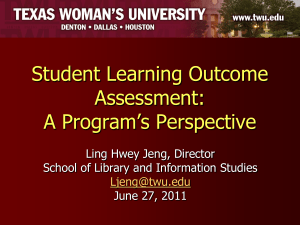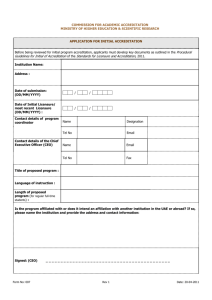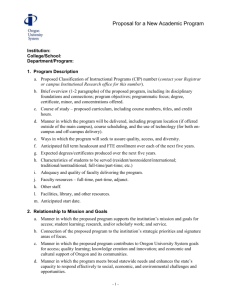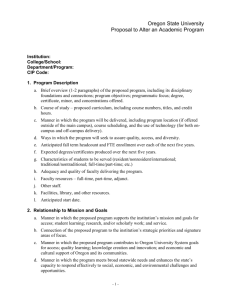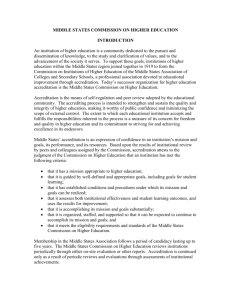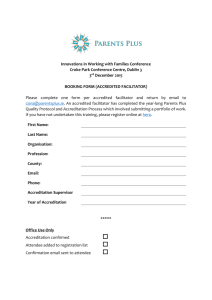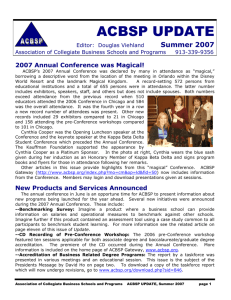Strategic Plan 2013-2018
advertisement
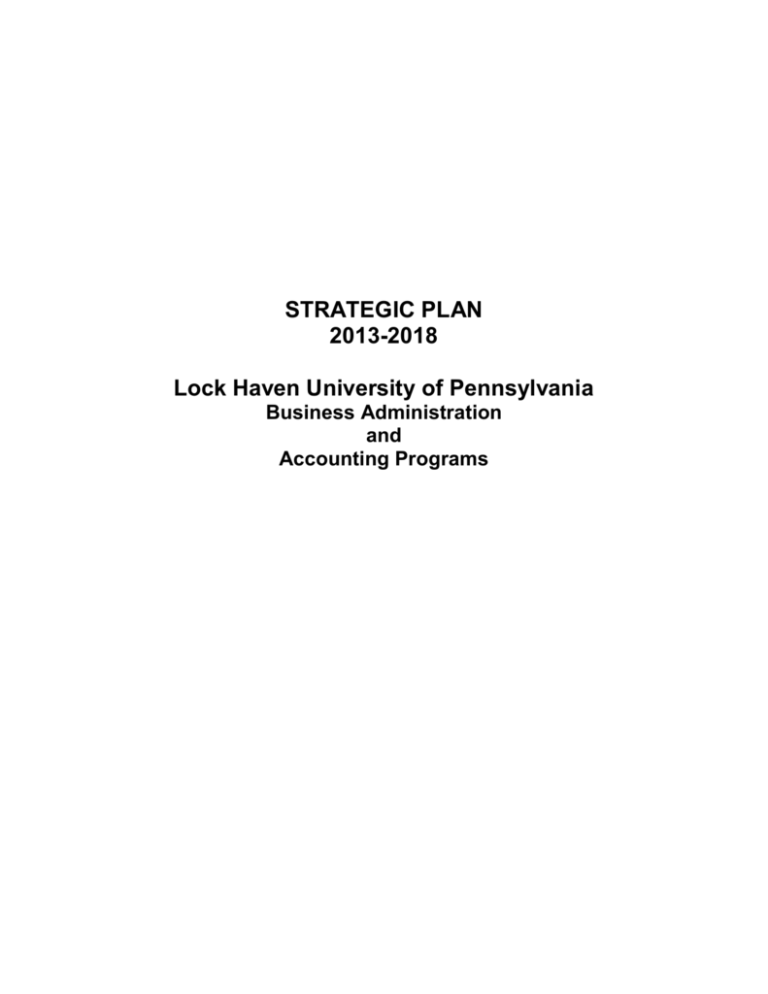
STRATEGIC PLAN 2013-2018 Lock Haven University of Pennsylvania Business Administration and Accounting Programs Introduction Business Administration and Accounting at Lock Haven University consist of a B.S. in Accounting, B.S. in Business Administration, A.S. in Business Administration, and a minor in business. The business programs are delivered at both the Main and Clearfield Campuses although the B.S. at Clearfield only includes the management and management information systems concentrations. In fall 2012, all of these programs were accredited by the Accreditation Council of Business Schools and Programs (ACBSP). The accreditation serves as an indicator of excellence and affirmation that the Programs have met or exceeded standards of quality. While the Programs appreciate this acknowledgment, the faculty members recognize through the accreditation process and means of assessment where focused efforts could strengthen the programs further and address emerging concerns. This document provides a brief statement of the Programs’ strengths, weaknesses, opportunities, threats, and strategic direction. From this information, the Programs have articulated goals, objectives, and action items that will enhance learning opportunities and elevate performance on student learning outcomes. Strengths The Programs enjoy several strengths upon which they draw to deliver a high-value educational experience. The recent ACBSP accreditation process highlights that the Programs exceed the accrediting standards in many ways, but especially with respect to faculty credentials and experience, curricular content and design, and systematic improvement processes. Clear policies for faculty recruitment, evaluation, promotion, and tenure enhance Program quality through the hiring and development of qualified faculty. One hundred (100) percent of courses are taught by faculty who are academically or professionally qualified. The Programs’ faculty members also bring an array of business and industry, and international experiences to the classroom. Students express satisfaction with the quality of instruction, faculty expertise, professors’ assistance with coursework, accessibility to faculty, and advising. The Programs’ faculty members maintain close relationships with other such key stakeholders as the Advisory Council, alumni, and community members who volunteer time to serve as guest lecturers and partners in experiential learning. They provide input to continuously improve the Programs, especially with respect to requisite knowledge and skills recent graduates should possess. Although the curriculum by far exceeds the undergraduate common professional component (CPC) prescribed by ACBSP, it addresses most content and skill areas (e.g., ethics, global perspectives, business law, communication, critical thinking, problem solving) that our stakeholders believe deserve greater attention for success in today’s world. The Programs’ robust stakeholder and student learning assessment plans provide insight into what areas our students excel and where they face greater challenge. Systematic processes for benchmarking and data collection/analysis lead to informed decisions and plans about the curriculum, learning activities (in and outside of the classroom), advising, and enrollment management. 07/2013 SP, p.2 Challenges Although the curriculum exceeds the CPCs required for accreditation, the student learning outcomes reveal that students face greater challenges in such content/skill areas as accounting, management information systems, quantitative problem solving, and communication. Greater integration and reinforcement of accounting, finance, problem-solving, and technology skills throughout the curriculum may be needed to address some of these weaknesses. The curriculum already includes several areas in which to introduce and reinforce communication skills, but within those areas, some new approaches to formative assessment and instruction may promote development of these skills. External stakeholders suggest that students lack knowledge and skill in such areas as business etiquette, professionalism, job search skills, resume writing, and interviewing. While the Programs include a few curricular components that address these skills, programs/services (e.g., career services) outside of business hold the primary responsibility for these areas. In addition, other departments outside of business deliver a portion of the required and elective courses, but have not updated syllabi and do not assess learning outcomes in these courses. Improved collaboration across departments and a more comprehensive approach especially to the skill areas may enhance learning outcomes. To adequately address some of these challenges in learning outcomes, the Programs require additional resources, but currently face challenges in resource acquisition which threaten advancement. The ACBSP Site Visit Team acknowledged the heavy faculty workload and unfulfilled requests for staffing. While the Programs have met or surpassed many of their goals over the last five years, insufficient resources have limited significantly course availability and selection; appropriate facilities, equipment, and support services; recruitment and retention strategies; scholarly activity (with release time); pedagogical and discipline-specific professional development (including travel); and further development of experiential learning at Clearfield. Resource acquisition serves as one of the primary weaknesses and underlies the inability to enhance efforts in several areas that would ultimately benefit student retention, learning, and development. Environmental Opportunities The accreditation self-study process provides an opportunity not only for the faculty and administration to critically review the Programs, but also to have external reviewers provide their insight and evaluation of what we do. The Site Visit Team prepared a Feedback Report which affirms many of the strengths and challenges and serves as an external benchmark for improving performance in a few areas. Meeting the standards and criteria, and receiving accreditation provides an opportunity to enhance the Programs’ image and attract domestic and international students who wish to attend an accredited program. Other such factors as emerging interdisciplinary programs (e.g., in arts, sciences, etc.), delivery of distance education, and 150-credit accountancy requirement may provide a few niche areas for recruitment although currently the Programs lack adequate resources to implement initiatives. In addition, the organizational restructuring gives the business and computer science programs more visibility in the University and their respective colleges which may aid recruitment and resource acquisition. 07/2013 SP, p.3 While accreditation may make LHU’s business program attractive, the state and national occupational outlook seems promising for many areas within business and accounting as well. The projections forecast an average to faster than average growth in the selected occupations (see table below) and less than average growth in financial managers, real estate, and insurance (claims adjuster, appraisers). Employment by Selected Business Occupations, 2010 and projected 2020 Occupational group Number of Jobs, 2010 Job Outlook, 2010-20 Accountants and Auditors Advertising, marketing, promotions Computer and Information Systems Managers 1,216,900 216,800 16% (average) 14% (average) Employment Change, 201020 190,700 29,400 307,900 18% (average) 55,800 Financial Analysts Human Resources Specialists Management Analysts Market Research Analysts 236,000 442,200 23% (faster than average) 21% faster than average) 54,200 90,700 718,800 282,700 157,200 116,600 Personal Financial Advisors Public Relations Managers and Specialists Sales Managers 206,800 320,000 22% (faster that average) 41% (much faster than average) 32% (much faster than average) 21% (faster than average) 342,100 12% (average) 40,100 66,400 68,300 With potential need in business occupations, we plan to recruit additional students and hope to be an integral part in the upcoming Capital Campaign. Additional funds through such an endeavor can lead to improved facilities, equipment, and instructional technology as well as scholarship monies to aid in recruitment of students. Although the search for new funding sources remains a concern and priority, the Programs feel fortunate to have very dedicated volunteers as an invaluable resource. The Advisory Council members, alumni, and business community members frequently give of their time and talents to sponsor or participate in student learning and program development activities. These opportunities serve as pivotal times in students’ careers where course concepts are realized in the real-world environment. Coupled with increased planning and involvement in professional development activities of the student business fraternity, Alpha Kappa Psi, students have available more opportunities for leadership and engagement. Along with internal units like career services, the Programs hope to create a more comprehensive career development program that would include participation of these internal and external key stakeholders. Threats Strategic challenges center on enrollment management and resource acquisition. Enrollment numbers, population demographics, and the state’s fiscal/economic condition as it relates to budget allocation serve as barriers for which we must plan. As stated in the enrollment management plan, the declining pool of high school graduates (expected to decline through 2018) coupled with an economic downturn has reversed our growth trends bringing about four consecutive years of enrollment declines. Particular to the Programs, the Admissions Office reports that the economy somewhat decreased prospective students’ interest in business and that the number of students 07/2013 SP, p.4 reporting SAT scores to LHU and institutions in the Middle States Region for businessrelated programs has declined in 2011. In addition, the Programs student body is markedly less diverse with a decreasing ability to recruit women, students of color, and international students. With respect to retention, the Programs have lower than desired retention rates. Students face such barriers as inadequate preparedness, financial difficulties, and personal circumstances, and either stop out or drop out. Changes in financial aid reporting, for example, stand to negatively influence retention of economicallydisadvantaged students, a significant population for the University. The Programs must investigate further what are these issues and what can be done at the program level to support students. Stated as a challenge, inadequate resources tend to inhibit growth and program development. Threats continue to loom in this area as the political environment seems less friendly to public higher education. State funding for PASSHE and its institutions has significantly decreased over the last decade with substantial cuts in appropriations in the last two years. With decreased funding, greater emphasis on external fundraising through grants will be more important, yet more competitive as other organizations turn to these options for additional revenue streams. Strategic Direction Over the last five years, the Programs developed and revised separate mission statements (for accounting and business) as a result of stakeholder input and benchmarking. In 2011, these statements were streamlined into a single mission. In 2012, the Business and Computer Science Department reviewed the Programs’ mission, vision, and values statements and adopted them with some modification. The new statements are more representative of the various program areas. The new mission also includes a reference to external experience; an addition suggested by student focus groups in several different sessions. The new department mission, vision, and values statements are listed below followed by the goals and action items used to accomplish those aspirations. Mission Statement Our programs prepare students to succeed in an increasingly competitive world through a variety of educational experiences including professional courses in a broad range of disciplines including Accounting, Computer Science, Economics, Entrepreneurship, Finance, Information Systems, International Business, Management, and Marketing within a strong liberal arts foundation. Students will acquire: Fundamental and in-depth knowledge in accounting, business, and computer science specializations Ability to research, analyze and solve ethical and discipline-specific problems Communication and teamwork skills External experience in professional settings 07/2013 SP, p.5 Vision Statement To transform traditional business and accounting education with an integrated curriculum and innovative approaches to classroom and experiential learning that cultivate real-world-ready graduates. Values Statement Our core values provide a foundation for all we do in our major programs. We value: Teaching and learning Mentoring through frequent interaction with our students and colleagues Building strong campus and community relationships Fair and ethical treatment Collegiality and respect for diverse opinions Program Goals Goal 1: Provide Quality Educational Experiences Objective 1: Continually improve curricular offerings Short-term Action Items: Update cycle of syllabi review schedule for 2013-14, revise syllabi, and submit to curricular review process Implement action items identified as a result of assessment data Implement action items identified as a result of assessment data Review/revise targets on core assessments Request a Confidential Review Copy of the new release (4JMF) of the Major Field Test, review the test, determine how well it aligns with the curriculum, and make necessary changes Fully implement Phase 3, SOLVE Concentration Assessments, gather and review baseline data on concentration assessments and determine specific learning outcomes targets Review 5-year course rotation schedule and identify target areas to expand course offerings to meet the needs of majors within and outside of the department (e.g., economics, finance, accounting) Assess impact of MANG105, ACCT110 changes on retention Review 5-year course rotation schedule and identify target areas to expand course offerings to meet the needs of majors within and outside of the department (e.g., economics, finance, accounting) Increase integration of technology throughout the curriculum Evaluate options for addressing the PA Accountancy requirements Determine student interest and options for increasing distance education delivery Long-term Action Items: Update 100% of the department syllabi on a 5-year rotation Fully implement the assessment plan for core and concentration assessments including closing the loop (e.g., including appropriate content and process changes) 07/2013 SP, p.6 Close the gap between expectations and student performance on learning outcomes assessment especially for accounting, finance, communication skills, and problem solving Benchmark, evaluate, and redesign (where appropriate) the curriculum to include standard business curricula; incorporate key areas identified by stakeholders; and identify niche areas Objective 2: Provide extra- and co-curricular opportunities for students to gain out-of-class experience Short-term Action Items: Create a database of internships and external experiences to clearly identify existing network as a foundation for expanding a network Identify at least two ELC lecture series speakers for 201314 Identify at least two ELC lecture series speakers for 2013-14 Identify alternative initiatives for developing the comprehensive programming for professional and job search skills Determine feasibility of starting student interest groups/clubs (e.g., investment club, mock trial team, etc.) to increase breadth of cocurricular opportunities Involve AKPsi in recruiting and out-of-class learning activities (e.g., orientation, open house, hold part in panel/lecture series, fundraising, etc.) Involve students in PASSHE Business Plan Competition Long-term Action Items: Build network of regional businesses and alumni willing to participate in such learning activities as internships, courseembedded projects, classroom lecturers, etc. Increase the percent of eligible students completing internships (credit and non-credit bearing) Identify resources to fund a business laboratory and/or incubator Annually sponsor at least five extra- and co-curricular lectures/speakers and professional activities with business leaders Develop a comprehensive means to address such skills as business etiquette and job search skills and such topics as professionalism and realistic expectations Increase involvement of student organizations and groups in at least two events annually Objective 3: Increase retention rates by five percent Short-term Action Items: Increase student/student and student/faculty interaction in new student orientation with potential involvement of Alpha Kappa Psi Participate in learning communities and incorporate more ADAC119 learning strategies in MANG105 Develop case statement which includes funding scholarships and experiential learning and present to LHU Foundation 07/2013 SP, p.7 Long-term Action Items: Define essential elements for a successful first-year experience (e.g., orientation, MANG105, mentoring, advising, communications, social) Enhance tutoring opportunities including a tutoring center for business and accounting Promote AKPsi (business fraternity) to students and develop opportunities for social interaction of majors Goal 2: Recruit, Develop and Retain Quality Faculty Objective 1: Provide adequate levels of staffing Short-term Action Items: Revise staffing plan and five-year course rotation to address areas identified under Goal 1, Objective 1 Assure 2013-14 temporary and tenure-track hires have credentials that keep the AQ/PQ status at or above target levels Hire one tenure-track position in management (IB/Bus Law) and in Economics Maintain student/faculty ratio Long-term Action Items: Continually study staffing levels, student enrollment, and course assignments to assure faculty sufficiency Maintain levels above the ACBSP standard for credit-hour production in business and accounting courses Objective 2: Promote Scholarly Growth, Professional and Intellectual Activities Short-term Action Items: Investigate opportunities to share resources across PASSHE Coordinate with TLC to sponsor a faculty lecture series 100% of tenured/tenure-track faculty to participate in at least one scholarly or professional development activity each academic year (ADMIN: Scholarly/Professional Growth) 100% of tenured/tenure-track faculty complete a scholarly activity within the five-year time period of the strategic plan (e.g., publish a paper, present paper/workshop/poster, submit grant proposal, or consult within the field) Long-term Action Items: Establish an ongoing record of faculty scholarly activity, professional development and business and industry interaction Seek resources to fund professional development 07/2013 SP, p.8 Goal 3: Promote the Business Administration and Accounting Programs Objective 1: Market the Programs and communicate with key stakeholders Short-term Action Items: Visibly promote initial accreditation to all key stakeholders including coordination with Admissions (recruiting), public relations, and administration in announcing and celebrating accreditation Identify items that address resource needs in each concentration as a foundation for the case statement Implement 2013-14 student/stakeholder assessments Contact new public relations staff (once hired) to discuss initiatives for promoting programs and submit and place at least 6 items for news releases or publications Update web and post promotional videos Improve use of social networking to connect with key stakeholders Identify requirements for ACBSP QA Report and integrate any additional initiatives into planning documents that are not currently included Long-term Action Items: Increase enrollment to targets prescribed in the enrollment management plan (ADMIN: Enrollment) Increase the number of communications with key stakeholders including greater promotion of learning activities and Program initiatives through the External Relations and Communication Department Review, revise (as needed), and implement student/stakeholder assessment plan and meet targets specified therein (ADMIN: Job Placement) Develop a case statement that gives a detailed description of resource needs Comply with ACBSP process of Maintaining Accreditation including collection of data and submission of Quality Assurance Reports Identify ways to promote faculty accomplishments Develop plan to connect with alumni especially through social networking (e.g., LinkedIn) Objective 2: Serve the community Short-term Action Items: Assess opportunities to involve the local business community in potential business travel summer programs that would involve students, faculty, and local business leaders. 100% of faculty to participate in at least one university/department service activity each year (ADMIN:Service) Long-term Action Items: Establish an ongoing record of faculty service Increase faculty and student involvement in the community at large Increase faculty and student involvement in the community at large 07/2013 SP, p.9 Implementation Each year during the life of the five-year plan, the Program faculty members will volunteer to implement specific strategies and monitor progress throughout the academic year by discussing plan initiatives and progress at each Program meeting (as a standing agenda item) and documenting results on the progress report (beyond what is documented in meeting minutes) at least once during each semester. At the conclusion of the academic year and in conjunction with the Annual Evaluation of Academic Programs (i.e., the Annual Reports), the Program faculty members will prepare the final Strategic Plan Progress Report to determine which short-term action items were accomplished; what progress has been made toward achieving the longterm objectives and targets; and where modifications are required to address emerging issues. From the data collection and analysis, the faculty members will establish shortterm action items with careful consideration of emerging challenges (risks) for the following academic year. Conclusion The Business Administration and Accounting Programs serve a state and national need to provide graduates who can compete in today’s business world. The Program faculty members recognize the myriad opportunities to provide a high-value program and enthusiastically embrace the goals to provide quality educational experiences; recruit, develop, and retain quality faculty; and promote the Programs. 07/2013 SP, p.10



